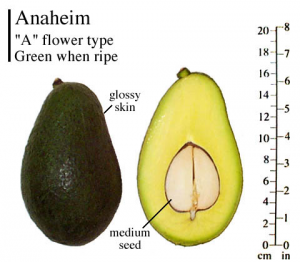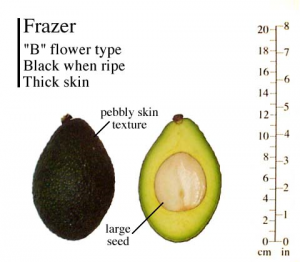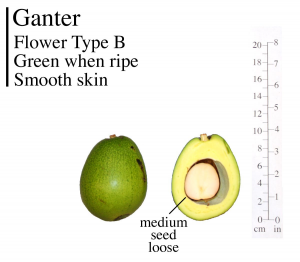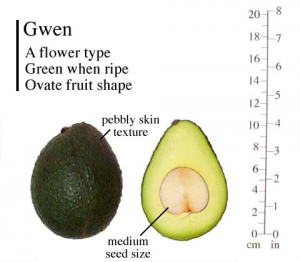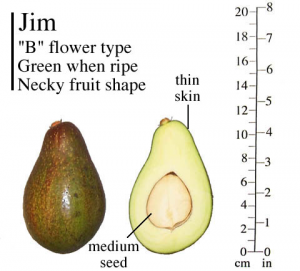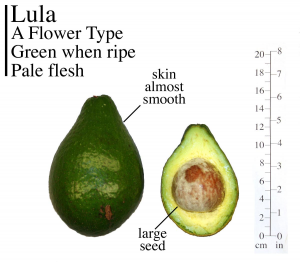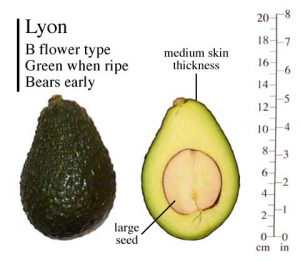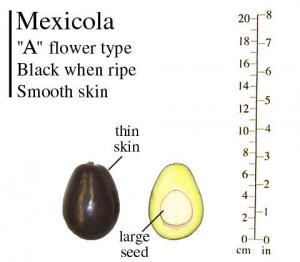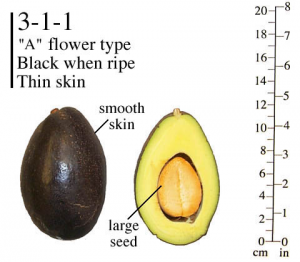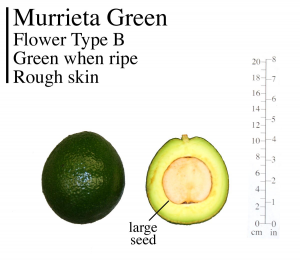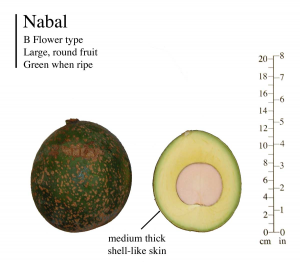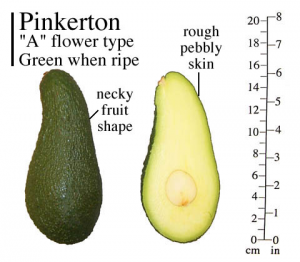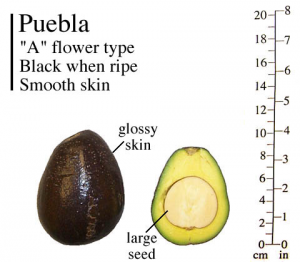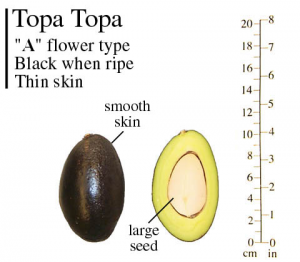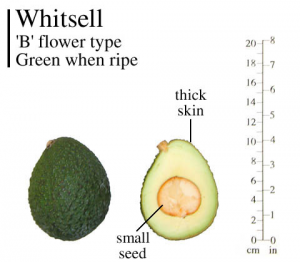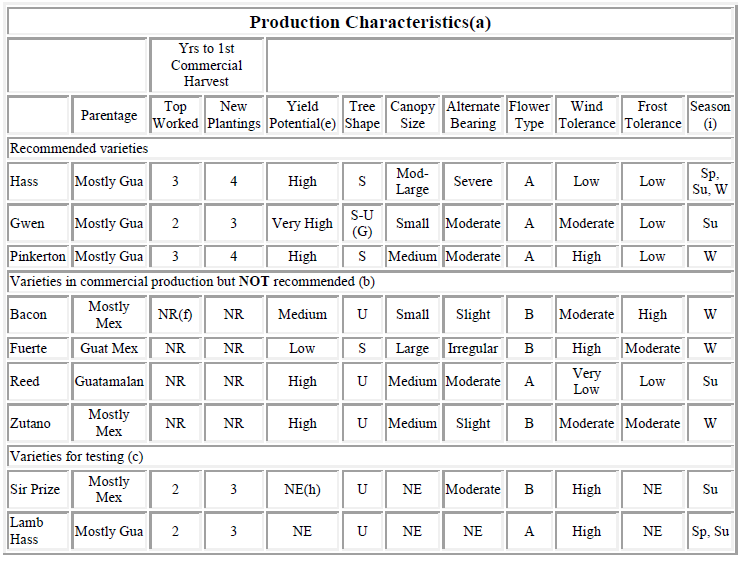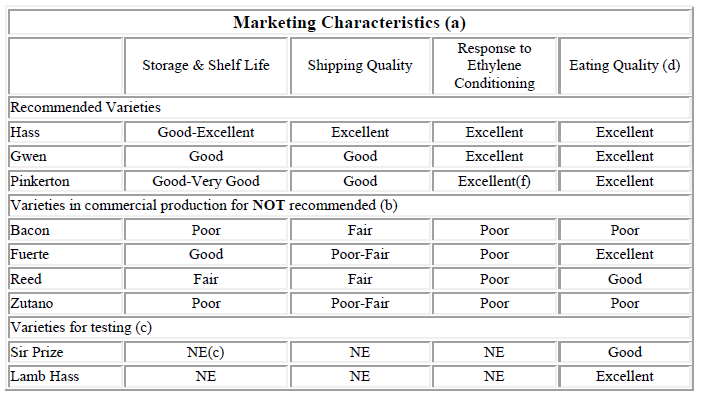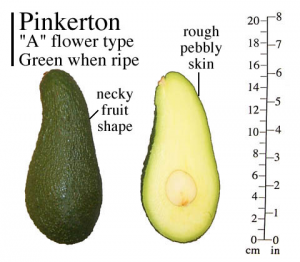Back to > Major Fruits | Minor Fruits | Underutilized Fruits
![]()
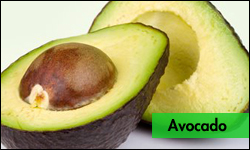 |
||
|
|
||
- Native to highlands ofMexico, Andes toChile, 2400 to 2800 m
- Flowers generally more pubescent (hairy); bloom earliest in the season.
- Fruits small; fruit skin thin to membranous, rarely over 0.75 mm; seed relatively large to very large, and often loose; fruit pulp commonly rich to strong in flavor, sometimes with anise aroma; often fibrous; ripen 6-8 months (rapid development)
- Leaves are “anise” scented; under-surfaces more glaucous (whitened with a bloom).
- Most cold hardy of the avocado races; also more resistant to heat and low humidity
- Trees found in higher elevations, hardy; least tolerant to soil salinity; arely does well in coastal environment
- Up to 30% oil
b)Guatemalan Race
- Native to highlands of Central America toEcuadorandMexico, 800 to 2400 m
- No anise leaf scent; young foliage more commonly reddish
- Large fruit, rough skin usually thick and leathery to woody, sometimes over 6 mm
- Fruits mature 9–14 months, winter cultivar
- Important commercial race; seeds are small, tight in cavity
- Trees cold resistant
- Hybrids of Guatemalan race most useful commercially
- 7.5 to 18% oil
c)West Indian Race
- Native to lowlands of Central and South America, only introduced intoWest Indies.
- No anise leaf scent
- Quite sensitive to cold
- Fruit size variable, skin thin and smooth leathery
- At point of fruit attachment, the pedicels have a unique nailhead configuration.
- Early maturing, 6 to 9 months (summer variety)
- Most tolerant to soil salinity
- Seeds loose, relatively large, can shake in fruit
- Cotyledons rough
- Pulp milk to watery in flavor
- 5–7% oil
Avocado fruits (Persea americana): A. West Indian cultivar, B. Guatemalan cultivar (‘Hass’), and C. Mexican x Guatemalan cultivar (‘Fuerte’).
a – General characteristics may vary according to climatic zones for all varieties
b – Other minor varieties including Anaheim, Covacado, Jim, McArthur, Rincon, Santana, Susan are also not recommended.
c – These varieties are considered to show promise, but need limited commercial testing. Data presented is only tentative.
d – Topworked trees may exhibit different tree shape. S=Spreading; U=Upright; I=Irregular.
e – Yields may be enhanced by cross pollination with opposite flower type which blooms at the same time.
f – NR = Not Recommended
g – Topworked trees tend to be more upright.
h – NE = not established
i – Fruiting Season: W=winter, SP=spring, Su=summer, Fa=fall
a – General characteristics may vary according to climatic zones for all varieties.
b – Other minor varieties including Anaheim, Covacado, Jim, McArthur, Rincon, Santana, Susan are also not recommended.
c – These varieties are considered to show promise, but need limited commercial testing. Data presented is only tentative.
d – Data presented from California Avocado Commission Consumer Taste Panel (1986-87) for all varieties except Whitsell.
e – NE = Not Established
f – Early season Pinkerton require ethylene conditioning for satisfactory ripening.
ate in thickness (1.0 mm). The seed is small (80 g) and is loose in the cavity. The flesh is yellow and is 80 per cent of the whole fruit by weight.
- Adame, E.L. 1994. Plagas del aguacate y su control. IV Curso de Aprobación Fitosanitaria en Aguacate. Facultad de Agrobiología. U. M. S. N. H. Uruapan, Michoacán, México.
- Armstrong, WP (2000). “Fruits Of The Rose, Olive, Avocado & Mahagany Families – Laurel Family: Lauraceae Extract from: http://waynesword.palomar.edu/ecoph17.htm#avocado
- “Avocados, raw, California”. NutritionData.com (2007). Retrieved on 2007-12-29
- Bailey, B.J., and P.M. Hoffman. 1980. Amorbia: ACalifornia avocado insect pest. Department of Entomology,University ofCalifornia, División of Agricultural Sciences. Leaflet 21256Riverside, Ca.U.S.A.
- Boyle, E.M. (1980). Vascular anatomy of the flower, seed, and fruit of Lindera benzoin. Bull. Torreya Bot. Club. 107:409-417.
- Bravo, M.H., et al., 1988. Plagas de frutas. Centro de Entomología y Acaralogía , Colegio de Posgraduados. Montecillo, México pp 49-236
- Bruno Razeto, Jose Longueira, and Thomas Fichet. (1992). Proc. ofSecond World Avocado Congress 1992 pp. 273-279
- California Avocado Comission (2007). Avocado.org. Retrieved March 1, 2007, Web site: http://www.avocado.org/
- Davenport, T.L. Avocado Flowering, Hort. Reviews 8: 257-289.
- Dowling, Curtis F.; Morton, Julia Frances (1987). Fruits of warm climates. Miami, Fla: J.F. Morton.
- “FATTY ALCOHOLS: Unsaturated alcohols”. CyberlipidCenter. Retrieved on 2007-12-29.
- Hirokazu Kawagishi, Yuko Fukumoto, Mina Hatakeyama, Puming He, Hirokazu Arimoto, Takaho Matsuzawa, Yasushi Arimoto, Hiroyuki Suganuma, Takahiro Inakuma, and Kimio Sugiyama. (2001). Liver Injury Suppressing Compounds from Avocado (Persea americana). J. Agric. Food Chem., 49 (5), 2215 -2221, 2001. 10.1021/jf0015120 S0021-8561(00)01512-0
- Koch, F.D. (1983). Avocado Grower’s Handbook, Bonsall Publications,
- López, E. 1990. Manejo de plagas de palta. In the international course: “Producción, Postcosecha y Comercialización de Paltas”. Facultad de Agronomía. Universidad Católica de Valparaíso. Viña del Mar, Chile.
- López-López, L., and Cajuste-Bontemps, J.F. 1999. Efecto del envase de carton corrugado y embalaje en la conservación de la calidad de fruta de aguacate CV. Hass. Revista Chapingo Serie Horticultura 5 Núm. Especial: 359-364.
- Martínez, B.R., and Adame, E.L. 1987. El minador de la hojadel aguacatero, dinámica de población, biología y control. Revista: Fruticultura de Michoacán. Año II, (I), 11pp. 5-26.Uruapan Michoacán.
- Minas K. Papademetriou (2000). Avocado Production in Asia and the Pacific. FOOD AND AGRICULTURE ORGANIZATION OF THE UNITED NATIONS
- REGIONAL OFFICE FOR ASIA AND THE PACIFIC
- BANGKOK,THAILAND, JULY 2000
- Naveh E, Werman MJ, Sabo E, Neeman I (2002). “Defatted avocado pulp reduces body weight and total hepatic fat but increases plasma cholesterol in male rats fed diets with cholesterol”. J. Nutr. 132 (7): 2015–8.
- Ohr, H. D. , M. D. Coffer, and R. T. McMillan, Jr. (2003) Diseases of Avocado (Persea americana Miller). http://www.apsnet.org/online/common/names/avocado.asp
- Ojewole JA, Amabeoku GJ. (2006). Anticonvulsant effect of Persea americana Mill (Lauraceae) (Avocado) leaf aqueous extract in mice. Phytother Res, 20(8): 696-700.
- SAGAR Secretaría de Agricultura, Ganadería y Desarrollo Rural. 1999. Revista “Claridades Agropecuarias”, No. 65 “El Aguacate”. Enero de 1999.
- Sánchez-Pérez, J. 2001. Aguacate en postcosecha. Boletín informativo de la APROAM El Aguacatero No. 5, http://www.aproam.com/aguacater5.htm SARH-DGSV. 1981. Lista de insectos y ácaros perjudiciales a los cultivos de México. 2a. Ed. Secretaría de Agricultura y Recursos Hidráulicos – Dirección General de Sanidad Vegetal. Fitófilo, No. 86: 1-196.
- Scora, Rainer. W. and Bergh, B. (1990). THE ORIGINS AND TAXONOMY OF AVOCADO (PERSEA AMERICANA) MILL. LAURACEAE. Acta Hort. (ISHS) 275:387-394
- Thorp, T.G. (1992). A study of modular growth in avocado (Persea americana Mill.) PhD.Dissertation. The University ofAdelaide,South Australia.
- Whiley, A.W. and B. Schaffer. (1994). Avocado, p. 3–35. In: B. Schaffer and P.C. Andersen (eds.). Environmental physiology of fruit crops. vol. 2. Sub-tropical and tropical crops. CRC Press Inc.,Boca Raton,Fla.
- Wikipedia, (2007). Avocado. Retrieved March 5, 2007, from Wikipedia Web site: http://en.wikipedia.org/wiki/Avocado
- Yahia, E.M. 2001. Manejo postcosechadel aguacate, In: Memoria del 1er. Congreso Mexicano y Latinoamericanodel Aguacate.Uruapan, Michoacán, México. Octubre 2001.
- Yahia, E. 2003. Manejo postcosechadel aguacate, 2ª. Parte. Boletín informativo de APROAM El Aguacatero, Año 6, Número 32, Mayo de 2003.


